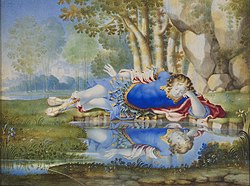File:Attributed to Henri Gascar - Portrait of the Grand Dauphin as Narcissus.jpg

Original file (1,444 × 1,074 pixels, file size: 1.13 MB, MIME type: image/jpeg)
Captions
Captions
Summary[edit]
| Henri Gascar: Portrait of the Grand Dauphin as Narcissus
|
|||||||||||||||||||||||||||||
|---|---|---|---|---|---|---|---|---|---|---|---|---|---|---|---|---|---|---|---|---|---|---|---|---|---|---|---|---|---|
| Artist |
|
||||||||||||||||||||||||||||
| Title |
Portrait of the Grand Dauphin as Narcissus label QS:Len,"Portrait of the Grand Dauphin as Narcissus" |
||||||||||||||||||||||||||||
| Object type |
painting |
||||||||||||||||||||||||||||
| Genre |
portrait |
||||||||||||||||||||||||||||
| Description |
|
||||||||||||||||||||||||||||
| Date |
17th century date QS:P,+1650-00-00T00:00:00Z/7 |
||||||||||||||||||||||||||||
| Medium |
gouache paint on vellum |
||||||||||||||||||||||||||||
| Dimensions |
height: 15 cm (5.9 in) dimensions QS:P2048,+15U174728 dimensions QS:P2049,+19U174728 |
||||||||||||||||||||||||||||
| Collection |
Private collection institution QS:P195,Q768717 |
||||||||||||||||||||||||||||
| Current location |
|
||||||||||||||||||||||||||||
| Source/Photographer | https://www.anticstore.art/95768P | ||||||||||||||||||||||||||||
Licensing[edit]
|
This is a faithful photographic reproduction of a two-dimensional, public domain work of art. The work of art itself is in the public domain for the following reason:
The official position taken by the Wikimedia Foundation is that "faithful reproductions of two-dimensional public domain works of art are public domain".
This photographic reproduction is therefore also considered to be in the public domain in the United States. In other jurisdictions, re-use of this content may be restricted; see Reuse of PD-Art photographs for details. | |||||
File history
Click on a date/time to view the file as it appeared at that time.
| Date/Time | Thumbnail | Dimensions | User | Comment | |
|---|---|---|---|---|---|
| current | 03:48, 30 January 2023 |  | 1,444 × 1,074 (1.13 MB) | Ecummenic (talk | contribs) | {{Artwork |artist ={{Creator:Henri Gascar}} |title ={{title|Portrait of the Grand Dauphin as Narcissus}} |description="This cabinet miniature is truly an artistic tour de force: in an area of just a few inches, the artist manages to portray Narcissus, who is reflected in the water in the foreground, and an attractive landscape behind him. The career of Henri Gascar, who was active on both sides of the Channel, could explain the strong influence of English miniaturists in this excepti... |
You cannot overwrite this file.
File usage on Commons
The following page uses this file:
File usage on other wikis
The following other wikis use this file:
- Usage on www.wikidata.org
Metadata
This file contains additional information such as Exif metadata which may have been added by the digital camera, scanner, or software program used to create or digitize it. If the file has been modified from its original state, some details such as the timestamp may not fully reflect those of the original file. The timestamp is only as accurate as the clock in the camera, and it may be completely wrong.
| Orientation | Normal |
|---|---|
| Horizontal resolution | 72 dpi |
| Vertical resolution | 72 dpi |
| Software used | Adobe Photoshop CC 2017 (Windows) |
| File change date and time | 22:44, 29 January 2023 |
| Color space | Uncalibrated |
| Date and time of digitizing | 17:44, 29 January 2023 |
| Date metadata was last modified | 17:44, 29 January 2023 |
| Unique ID of original document | xmp.did:a27b4949-9cf4-7b4c-8039-2835a7e55cbb |
